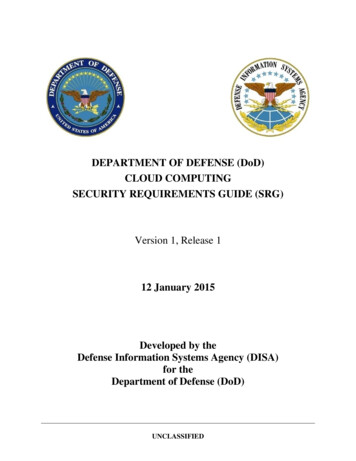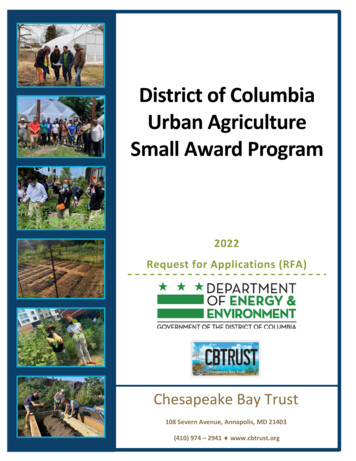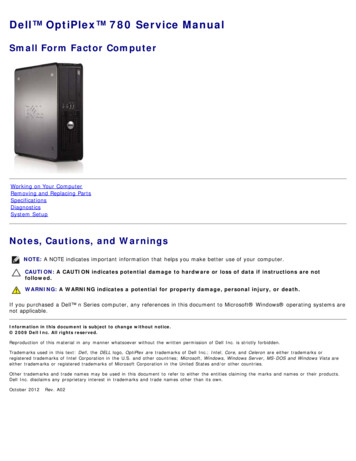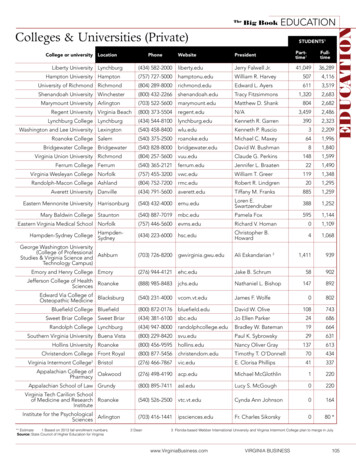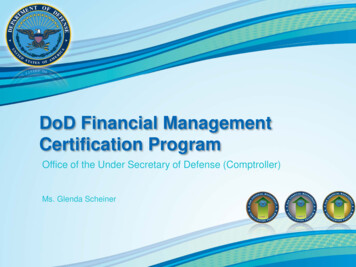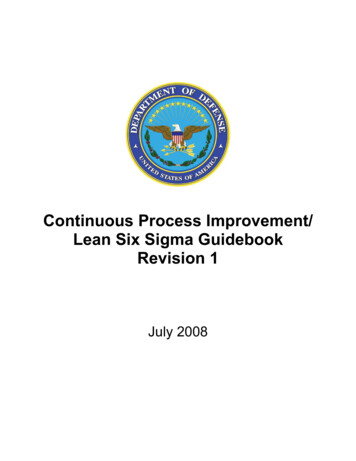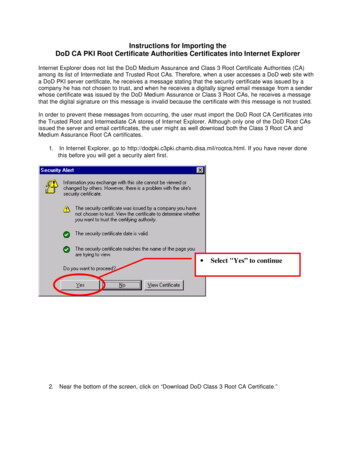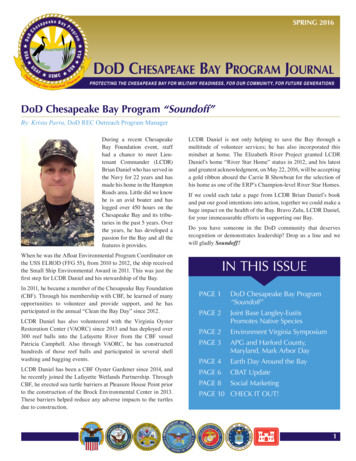
Transcription
SPRING 2016DoD Chesapeake Bay Program JournalPROTECTING THE CHESAPEAKE BAY FOR MILITARY READINESS, FOR OUR COMMUNITY, FOR FUTURE GENERATIONSDoD Chesapeake Bay Program “Soundoff”By: Krista Parra, DoD REC Outreach Program ManagerDuring a recent ChesapeakeBay Foundation event, staffhad a chance to meet Lieutenant Commander (LCDR)Brian Daniel who has served inthe Navy for 22 years and hasmade his home in the HamptonRoads area. Little did we knowhe is an avid boater and haslogged over 450 hours on theChesapeake Bay and its tributaries in the past 5 years. Overthe years, he has developed apassion for the Bay and all thefeatures it provides.LCDR Daniel is not only helping to save the Bay through amultitude of volunteer services; he has also incorporated thismindset at home. The Elizabeth River Project granted LCDRDaniel’s home “River Star Home” status in 2012, and his latestand greatest acknowledgment, on May 22, 2016, will be acceptinga gold ribbon aboard the Carrie B Showboat for the selection ofhis home as one of the ERP’s Champion-level River Star Homes.If we could each take a page from LCDR Brian Daniel’s bookand put our good intentions into action, together we could make ahuge impact on the health of the Bay. Bravo Zulu, LCDR Daniel,for your immeasurable efforts in supporting our Bay.Do you have someone in the DoD community that deservesrecognition or demonstrates leadership? Drop us a line and wewill gladly Soundoff!When he was the Afloat Environmental Program Coordinator onthe USS ELROD (FFG 55), from 2010 to 2012, the ship receivedthe Small Ship Environmental Award in 2011. This was just thefirst step for LCDR Daniel and his stewardship of the Bay.In 2011, he became a member of the Chesapeake Bay Foundation(CBF). Through his membership with CBF, he learned of manyopportunities to volunteer and provide support, and he hasparticipated in the annual “Clean the Bay Day” since 2012.LCDR Daniel has also volunteered with the Virginia OysterRestoration Center (VAORC) since 2013 and has deployed over300 reef balls into the Lafayette River from the CBF vesselPatricia Campbell. Also through VAORC, he has constructedhundreds of those reef balls and participated in several shellwashing and bagging events.LCDR Daniel has been a CBF Oyster Gardener since 2014, andhe recently joined the Lafayette Wetlands Partnership. ThroughCBF, he erected sea turtle barriers at Pleasure House Point priorto the construction of the Brock Environmental Center in 2013.These barriers helped reduce any adverse impacts to the turtlesdue to construction.IN THIS ISSUEPAGE 1DoD Chesapeake Bay Program“Soundoff”PAGE 2Joint Base Langley-EustisPromotes Native SpeciesPAGE 2Environment Virginia SymposiumPAGE 3APG and Harford County,Maryland, Mark Arbor DayPAGE 4Earth Day Around the BayPAGE 6CBAT UpdatePAGE 8Social MarketingPAGE 10 CHECK IT OUT!1
Joint Base Langley-Eustis Promotes Native SpeciesBy: Tim Christensen, Joint Base Langley-Eustis and Christine Yott, Michael Baker InternationalJoint Base Langley-Eustis (JBLE-E), with primarily Armytenants, is managed by the United States Air Force. Within thissmall installation (about 7,900 acres), which houses an Armyairfield and a port facility, are approximately 3,600 acres ofwetlands and approximately 2,700 acres of forest habitat.The 733rd Mission Support Group (MSG) provides the servicesnecessary to run JBLE-E efficiently, and includes a securitysquadron, civil engineer division, logistics readiness division,and mission services division. The 733rd MSG has beenimplementing projects to control invasive vegetation and promotenative species in order to work towards healthy habitats thatsupport the mission, promote biodiversity, prevent soil erosion,improve aesthetics, and improve water quality. Invasive Species Management – Some 22 invasive plants aredocumented on JBLE-E. Several of these impact militarymissions and adversely affect natural areas. Common reed,tree of heaven, Chinese privet, Japanese honeysuckle, kudzu,and golden bamboo are among the more significant species.The 733rd MSG and Army Support Activity have beenworking together to control invasive vegetation throughoutJBLE-E, including several training areas, non-training areas,and special areas around the cantonment area. Riparian Forest Planting – The 733rd MSG converted anold wastewater treatment plant along Milstead Island Creekto a riparian forest, with approximately 200 hardwood treesplanted. Longleaf Pine Reintroduction – JBLE-E initiated thereintroduction of native longleaf pine trees in 2014, and roughlysix acres have been re-established to date. Mixed Oak Replenishment – Around 100 mixed oaks wereplanted in an isolated natural area along Washington Boulevardand Taylor Avenue, after 100 dead trees and loblolly pineovergrowth were removed from five acres of forest habitat.Timber stand improvement also took place in the Browns Lakearea, where 30 dead trees were replaced with 75 mixed oaks. Reforestation – JBLE-E reforested approximately 20 acres oftraining area by removing a large volume of dead loblolly pines,performing a timber sale of remaining marketable timber, andreplanting with 1,400 native hardwood trees.Environment Virginia SymposiumBy: Christine Yott, Michael Baker InternationalThe 27th Environment Virginia Symposium (EVS) was heldApril 5–7 at the Virginia Military Institute (VMI) in Lexington,Virginia. Each year, the EVS welcomes participants from thepublic, private, and nonprofit sectors to learn about environmentaltopics important to Virginia. The EVS includes exhibits andpresentations from professionals that share case studies, researchand technology, regulatory information, success stories, andlessons learned. This year’s EVS was co-hosted by the VirginiaDepartment of Environmental Quality, Virginia Departmentof Conservation and Recreation, and Virginia EnvironmentalEndowment.The US Fleet Forces Environmental and DoD ChesapeakeBay Program (DoD CBP) had a booth at this year’s EVS thatreceived many visitors interested in learning more about thePrograms. In addition, Sarah Diebel and Dave Cotnoir presentedinformation on DoD actions in relation to the Chesapeake BayTMDL. Combined, the booth and presentation provided the CBPnew contacts and outreach opportunities. We encourage othermembers of the Chesapeake Bay Action Team (CBAT) to attendnext year’s EVS as an opportunity to both present and learn.2Photo by Jeff Laitila, DoD Chesapeake Bay ProgramThe EVS is not limited to Virginia workers; many of the topics(Chesapeake Bay watershed, environmental education, etc.) arerelevant to everyone in the CBAT.
APG and Harford County, Maryland, Mark Arbor DayBy: Yvonne Johnson, APG NewsOn March 25, 2016, Aberdeen Proving Ground received its 11thTree City USA recognition and its 9th Tree City USA GrowthAward during Harford County’s annual Arbor Day celebration.The event was held at Willoughby Beach Road in Edgewood,on land purchased by the Harford Land Trust with fundingassistance from the Army Compatible Use Buffer, or ACUB,program. ACUB is an Army-wide program that purchases landnear installations to create “buffer” zones to enhance and sustainArmy missions of Soldier training and testing.According to APG Garrison Commander Col. James E. Davis,the acquisition was a perfect example of an Army installationjoining forces with surrounding communities to find a mutuallybeneficial solution. Frank Lands, deputy to the Garrisoncommander, explained that the buffer provided through theACUB program benefits the installation by preventing theencroachment of housing developments and benefits HarfordCounty by providing public parkland.Hundreds of adults and children, including local scouts, turnedout for the event on the 48-acre parcel of land, where 200 saplingswere planted before the day was out. Brad Killian, Director of theHarford County Department of Planning and Zoning, encouragedparticipants to plant the trees with care. “We’ll come back nextyear and see them thriving,” he said.One ceremonial planting was dedicated to the late Jim Thomas,former chairman and vice chairman of the Harford CountyForest Conservancy District Board. Thomas, who passed awayin January at age 96, was an avid outdoorsman who left asizeable portion of his estate to the Harford Land Trust. HarfordCounty Councilman Chad Shrodes said that Thomas wouldheartily approve of the project. “He was one of the county’sfirst conservationists, and he was still planting trees in his 90s.”“Photo by U.S. Army photo by Molly Blosse, APG News:From right, Harford County Executive Barry Glassman and APG GarrisonCommand Sgt. Maj. Jeffrey Adams watch a volunteer place a sapling in theground as Harford County Councilman Chad Shrodes helps his daughterMadelyn, 6, with her shovel during the Arbor Day tree planting in Edgewood,Maryland, March 25, 2016.“He knew planting trees and preserving land would createhabitats,” Shrodes said. “This [ACUB program] allows us topreserve a piece of property that would otherwise be constructed.”The ACUB program manager at APG is Harford Countyemployee Todd Beser. Beser said the primary goal of the programis to protect the installation’s mission, but being able to completethat goal on the Chesapeake Bay makes it more special.“Seeing years of work, from both Harford Land Trust and myself, come to fruition was very satisfying,” Beser said. “It was agreat pleasure to see the community, Harford County and Garrison leadership, and especially the kids all working together toimprove the local landscape and—whether they knew it or not—protecting the mission of APG at the same time.”continued on page 5“APG’s 11th recognition as a Tree City USA community reflectsits commitment to urban forestry, and its 9th Tree City USAGrowth Award was received for demonstrating progress inits community forestry program. John Wrobel, chief of theHarford County Natural Resource Branch, Directorate of PublicWorks, commented that “APG’s contribution, as one the largestlandowners of forested areas in Maryland–nearly 17,000 acres–to overall health of the [Chesapeake] Bay is considerable andpositive.” According to Wrobel, “APG executes a robust forestmanagement program with a 50-year plan of forest management to ensure that the existing natural infrastructure of APG willcontinue to support the current and future test mission at APG.”In addition to their beauty,” Wrobel said, “trees are actively working toreduce pollution and improve the overall health of our eco-system.3
Earth Day Around the Chesapeake BayBy: Christine Yott, Michael Baker International with contributions from Major Peter A. Baker, United StatesMarine Corps Base Quantico; Keirah O. Mills, Fort A.P. Hill; Stacey M. Rosenquist, Arlington National CemeteryEarth Day was founded in 1970 by Senator Gaylord Nelson as agrassroots effort to increase awareness of environmental issues.Since the 1990s, military services have typically celebratedEarth Day with “green” installation events open to the publicand/or military personnel, as well as participated in communityand educational outreach activities.On April 20 and 21, Marines and USMCB Quantico’s forestersplanted 4,500 loblolly pine trees in an approximately 10-acre areaof land, and planted 150 fruit trees of mixed species at severallocations on base, including Hospital Point, Whiskey Gulch, TheBasic School, and the recycling warehouse.This year was no different. In celebration of Earth Day, militaryservices throughout the Chesapeake Bay participated in a multitudeof environmental stewardship activities. Service members andcivilians volunteered to give back to their communities throughwetland and dune restoration efforts, litter cleanup events alongrivers and streets, installation of walking paths with clam shells,and adding compost and mulch to plant beds.Fort A.P. HillOn April 21, Fort A.P. Hill’s environmental staff welcomedalmost 1,200 visitors from local schools to participate in itslargest Earth Day celebration to date.Increasing awareness, internally and externally, of the importanceof caring for the environment is vital. Earth Day expos were setup to reach large numbers of people, and educational activitiesand tree plantings were held at child development centers.USMCB QuanticoPhoto by Landon Webb, Forestry Technician at A.P. Hill: Students learn theprocess of seed fertilization and growth as they make their own take-homeseed packets.Photo by Ronald R Moyer: May 5, 2016, at The Basic School, dedicated to theMontford Point Marines. From left to right: Justin Jennings (Forester); T.R.Baun (Forestry Equipment Operator); Chris Crawford (Forester); active dutyMarines Capt. Stephen Glascock, GySgt. Scott Beebe, and Sgt. Robert Simon;and Stefany Grieco (NREA GIS Specialist).This annual event has a long-standing legacy of quality andexcellence with the neighboring community, due in large measureto the support it receives from environmental organizations thatvolunteer their time as exhibitors. Almost 50 organizationsfrom outside the installation supported this event by providinghands-on exhibits and direct engagement with students. Militarytenants on post also provided a hands-on perspective of whyenvironmental stewardship and management is required – tomaintain the quality of the land needed to train the Nation’smilitary forces.The Earth Day Network used this year’s theme, “Trees for theEarth,” to launch an initiative to plant 7.8 billion trees by the 50thanniversary of Earth Day in 2020. This is equivalent to one treefor every person on the planet. The purpose of this initiative is tobring awareness to climate change and air pollution; support localeconomies; promote biodiversity; and encourage environmentalstewardship. USMCB Quantico is joining this initiative byplanting one tree for each of the 4,300 Marines who live on base.Throughout the day, the students were exposed to a diversityof environmental organizations, from natural resources andwildlife conservation groups to outdoor recreation clubs, localsustainable farms, historic societies, and even law enforcementand military factions. For many students, it is Earth Dayevents like this that first come to mind when they are askedabout the installation. Celebrations like this, in fact, are theinstallation’s principle outreach event to engage the community4
continued from page 4Arlington National Cemeteryon environmental awareness and conservation, while promotingsustainable military land management.Arlington National Cemetery (ANC) has long been recognizedas a place of beauty, with the trees and plantings contributinggreatly to the overall character and iconic image of the cemeteryas one of the Nation’s most sacred places.In addition, the Fort A.P. Hill environmental staff integrates itsannual environmental awareness training for the installationworkforce. This hands-on training provides face-to-face interactionbetween the environmental subject matter experts and the staff.Posters and displays highlight mission-relevant aspects of FortA.P. Hill’s Sustainability/Environmental Management Systemsprogram, Hazardous Waste and Recycling, Water Quality, andNatural and Cultural Resources Management.This year, ANC Horticulturist Kelly Wilson and EnvironmentalProtection Specialist Stacey Rosenquist led a tour of the cemeterygrounds. The tour focused on how ANC is helping to protect theChesapeake Bay from pollutants and to sustain the 3 B’s.bees,butterflies, and birds.Photo by Rachel LaRue: Flowering trees at Arlington National Cemetery.APG and Harford County, Maryland, Mark Arbor Daycontinued from page 3Land parcels purchased through ACUB provide additional greenspace in the community, protect vital habitats, and support Chesapeake Bay Executive Order 13508. The buffer program has contributed more than 1.3 million to help the trust buy five properties (totaling about 130 acres) in the unincorporated communityof Edgewood since 2013. Beser said APG has additional ACUBproperties in the pipeline, on both the western and eastern shoresof the Chesapeake Bay.John Wrobel said Harford County team members are hard atwork using silviculture–the growing and cultivation of trees–toimprove forest stands that have been quantified to control runoff,reduce pollution in the bay, and improve ecological habitats forwildlife. One recent team project included controlled burns toremove invasive species and improve range infrastructure. APGhas long recognized the importance of forestry and its positiveimpact in fighting pollution, he said.Another of this year’s “good news” stories comes from the Chesapeake Water Quality Goal Implementation Team, which has approved the recommended loading rates for the new Tree CanopyLand Uses in the Chesapeake Bay model. Research and experimental procedures determined the significant pollution-fightingpower of the tree canopy in reducing the amount of nitrogen, phosphorus, and sediment entering the bay from surface-water runoff.Wrobel added that additional research has determined that treescan be used to treat contaminated groundwater through a processcalled phytoremediation. This technique, spearheaded by APG inthe 1990s through research, development, and implementation, isin its 20th year of being used to treat contaminated groundwaterat the Superfund Site J-Field, he said.5
CBAT UpdateBy: Christine Yott, Michael Baker InternationalUSGS Federal Facility Editor ToolAndy Fitch spoke to the Chesapeake Bay Action Team (CBAT)on the United States Geological Survey (USGS) Federal FacilityEditor Tool, which will support the Phase VI Watershed Modelcoming out later this year. The web-based and map-centrictool calculates the effects of Federal facility land use on theChesapeake Bay watershed. The tool will also provide specificland-use definitions.The Federal Facility Workgroup is collaborating on how to furtherimprove the tool. Currently, the workgroup is trying to obtainupdated boundaries for the facilities. County governments arealso being asked to provide feedback to improve the tool. Oncethe tool updates are ready (approximately summer 2016), userswill be asked to verify the accuracy of the land-use types at eachof their facilities by viewing the data and sending information onneeded changes back to the workgroup. The workgroup will needto finalize this information by approximately the end of Augustfor use in the Phase VI Watershed Model.Sarah Diebel and Laura Muhs will work on the geographicinformation system (GIS) coordination for a full DoD submittal.Therefore, Service leads should be ready to submit GIS andproperty information. A timeline will be generated once theworkgroup has had a chance to meet with the EnvironmentalProtection Agency (EPA) to determine when to make a submittal.before increasing slightly and then leveling off, the other riverbasins have maintained more or less the same nitrogen loadssince monitoring began in 1985.Data indicate more short-term degradation (2005–2014, atfour stations) than long-term (1985–2014, at one station) forphosphorus loads. The Susquehanna contributes most of theloads (45%), followed by the Potomac (29%) and the James (18%).The Susquehanna’s phosphorus loads have degraded significantlyover the short term, the Potomac has improved over both the longterm and the short term, and the James has improved over thelong term but is now showing a slight degradation.DoD Fiscal Year (FY) 15 Chesapeake BayAnnual Progress ReportRegional Environmental Coordination (REC) Chesapeake Baystaff finalized the report covering FY15 DoD accomplishmentsrelated to Chesapeake Bay protection and restoration in theareas of water quality, climate change, natural resources, andland conservation. The report includes updates to programmaticactions associated with 2014/2015 two year milestones, fundingtables, and future initiatives. Copies will be made available on theDoD Environmental, Safety and Occupational Health Networkand Information Exchange (DENIX) / REC DoD ChesapeakeBay Program’s website – http://denix.osd.mil/chesapeake/USGS Non-Tidal Monitoring NetworkDouglas Moyer of the USGS leads a team of researchers whomonitor water quality and study how pollutant loads arechanging as a result of human activity. Mr. Moyer’s presentationto the CBAT discussed trends in nitrogen and phosphorus loadsfor non-tidal river basins, and a handout included further dataon sediment loads. The information that was discussed can bedownloaded from http://cbrim.er.usgs.gov/DoD CHESAPEAKE BAY PROGRAMFY2015 Annual Progress ReportApril 2016Nitrogen data from non-tidal monitoring stations show that thehighest loads in the Chesapeake Bay watershed are concentratedin agricultural areas. Overall, nitrogen loads show improvementfor the majority of sites (54%), while 27% show degradation and19% show no detectable trend. Phosphorus loads for the majorityof sites (68%) have improved, while 20% show degradation and12% show no detectable trend.Data show that the vast majority of non-tidal sourced nitrogenloads are from the Susquehanna (64%), followed by the Potomac(24%). While Susquehanna nitrogen loads decreased for a decadecontinued on page 76
CBAT Update continued from page 6Scientific Technical Advisory Committee MeetingIn March, Roberta Person attended the Scientific TechnicalAdvisory Committee (STAC), which presented: Results of the Smithsonian Environmental Research Centerstudy on factors that should be considered to promotesubmerged aquatic vegetation (SAV) health when choosingshoreline armoring designs. The study found that land use anddrainage basins were the most important factors, with salinityalso having an important effect. EPA’s advocacy for shoreline project verification to ensure thatprojects are having the intended effect and STAC attendees’subsequent need for EPA guidance on the verification process.Local Area Targets Task ForceCBP is participating on the Local Area Targets Task Forceas the Federal representative. The Task Force is makingrecommendations regarding how local area targets (LATs)will be determined within the framework of Phase IIIWatershed Implementation Plans (WIPs). The Task Forceis considering jurisdictions’ efforts and methods to developLATs and recent work to establish Federal facility targets.Task Force recommendations will inform the Phase III WIPexpectations. The group’s website can be accessed al area targets task forceChesapeake Bay Accountabilityand Restoration Act of 2014Under the Chesapeake Bay Accountability and Restoration Actof 2014 (CBARA), the Director of the Office of Managementand Budget (OMB) is required to submit to Congress anannual financial report by 30 September containing aninteragency crosscut budget for Federal restoration activitieswith funding amounts of 300,000 that protect, conserve, orrestore living resources, habitat, water resources, or waterquality in the Chesapeake Bay watershed. REC ChesapeakeBay staff participated with other Federal agencies to discussreporting procedures for CBARA on 5 May. Staff made severalrecommendations to OMB on their draft budget data request(BDR); the release of the BDR is still to be determined. RECChesapeake Bay staff are working to establish what DoD willreport and notify appropriate chain of command.Clean the Bay Day StatsNavy by theNumbersSupreme Court Denies Hearingfor Chesapeake Bay TMDL ChallengeThe Chesapeake Bay total maximum daily load (TMDL),commonly known to the public as the “pollution diet,” has beenchallenged by advocacy groups since it was first implemented. Inparticular, the American Farm Bureau Federation, the NationalAssociation of Homebuilders, and their supporters mounted alegal claim that the EPA overstepped its authority when issuingthe Chesapeake Bay TMDL. Challengers asserted that theEPA was acting as a Federal zoning board, with significantpower over land-use decisions. Supporters emphasized that theTMDL is in fact a collection of State programs consistent withother environmental programs. Because the court declinedto hear the case, the appeals court’s opinion stands that theTMDL allows EPA and States to collaborate to “best allocatethe benefits and burdens of lowering pollution.” With the legalchallenge settled, environmental advocacy groups hope torefocus attention on achieving the TMDL goals for restoringthe health of the Chesapeake Bay.From nine Navy installations,919 total volunteersremoved 48,430 poundsof trash and debrisalong more than 72 milesof streams and shoreline.Most common items were plastic bags and bottles.Some of the most unusual/interesting items foundwas an entire piece of a pier at Naval WeaponsStation Yorktown, a 1960 Pepsi bottle worth 35today from Norfolk Naval Shipyard, and a stuffedteddy bear wearing mardi gras beads fromLafayette River Annex.7
Social Marketing – Another Tool for Positive Environmental ChangeBy: Christine Yott, Michael Baker InternationalAccording to the United States Environmental ProtectionAgency (EPA), “Outreach and education can help create anawareness of the value of our water resources, educate peopleabout what’s threatening the resources, and encourage protectiveaction.” As members of the Department of Defense ChesapeakeBay Program, we also know the importance of using outreachand education programs to influence positive change within theChesapeake Bay watershed.On 18 May 2016, the Center for Watershed Protection hosteda webinar on education programs and social marketing toolsto enhance efforts to reduce pollution. Speakers included thefollowing national experts: Karen Cappiella, Program Director, Research,Center for Watershed Protection Steve Raabe, President of OpinionWorks Stephanie Shamblin Gray, Water Project Engineerfor HDR, Inc.Background and PurposeOutreach and education has evolved from a one-dimensionalreliance on public service announcements to a more sophisticatedapproach based on commercial marketing techniques, termed“social marketing.” Social marketing involves listening to theneeds and desires of the target audience—such as the residentsof a Federal facility—to build a program. As with commercialmarketing, the primary focus is on the consumer—learning whatpeople want and need, rather than trying to persuade them tobuy what happens to be produced. Presenters at the webinardiscussed how to use social marketing in watershed protection.Social Marketing ProcessWhile the bell curve below was developed to explain thesuccessive groups of people that adopt new technologies,the same theory can be applied to adopting environmentalstewardship behaviors. The innovators and early adopters donot require education campaigns to embrace a new idea; earlymajority and late majority adopters are the target audience forPhotoBizCoach.com, BeateChelette.com8
Social Marketing continued from page 8social marketing; and laggards are the ones who resist behaviorchange until legal intervention requires it.Social marketing involves the following process:4 Identify the problem to be solved and use this to determinethe campaign’s purpose and focus4 Pinpoint your target audience (i.e. who in the communitymight be performing actions that lead to the problem?)4 Identify the specific behavior you want the audience toembrace4 Assess the barriers to taking action (e.g. money, convenience)4 Find the benefits and motivators that will overcome thesebarriers (e.g. incentives, process change).4 Refine your messages, incentives, and tools , then determinewhere and how you will deliver them to the target audience4 Evaluate and measure your progressPilot Stewardship IndicatorOne of the 10 goals of the 2014 Chesapeake Bay WatershedAgreement is “to increase the number and diversity of local citizenstewards that actively support and carry out the conservationand restoration activities ” To this end, the 2016-2017 CitizenStewardship Work Plan includes conducting a watershed-widepilot program to measure stewardship. The graph below showsinitial results of the pilot survey. As the pilot continues, resultsmay be used to identify behaviors that can be targeted throughsocial marketing.Useful ResourcesMaryland’s Reclaim the Chesapeake BayPublic Awareness CampaignChesapeake Bay TrustEPA’s Getting In Step Outreach Series9
DoD/DoN Chesapeake Bay Program Office1510 Gilbert StreetBuilding N-26, Room 3300Norfolk, VA 23511Check it OutChesapeake Bay Program Websitehttp://denix.osd.mil/chesapeake/The new Chesapeake Bay Program (CBP) website is up andrunning! We will be using this as a communication tool forthe CBP. As the website continues to evolve, it will becomea central location for meeting minutes, data calls, good newsstories, and other relevant items.Updated Virginia Runoff Reduction MethodCompliance Spreadsheet (v e.aspxVirginia Department of Environmental Quality has updatedthe Virginia Runoff Reduction Method Compliance Spreadsheet and associated User’s Guide. The update improvesfunctionality and summary reporting. It also fixes variousinconsistencies, and reduces the number of spreadsheets fromfour to two; New Development and Redevelopment.Training: Using the DOEE’s Stormwater DatabaseThis training focuses on using the Stormwater Database inthe submission process for DDOE review of Stormwater Management Plans (SWMPs), Soil Erosion and Sediment Control(ESC) Plans, and Green Area Ratio (GAR) Plans, and for participation in the SRC and RiverSmart Rewards programs. Thetraining includes an overview of database functions and exercises to enter mock plans and applications. For all sessions,please RSVP by registering online https://octo.quickbase.com/db/bjwsjjug5?a q&qid 7 or by contacting Matt Johnson atMatt.Johnson2@dc.gov or (202) 741-0861. Tuesday, May 24, 2016: 1 pm – 4 pm – DOEE Room 509 Thursday, June 23, 2016: 1 pm – 4 pm – DOEE Room 509 Thursday, July 14, 2016: 9 am – 12 pm - DOEE Room 509This newsletter is produced by Michael
ongleaf Pine Reintroduction - JBLE-E initiated the L reintroduction of native longleaf pine trees in 2014, and roughly . six acres have been re-established to date. ixed Oak Replenishment - Around 100 mixed oaks were M planted in an isolated natural area along Washington Boulevard and Taylor Avenue, after 100 dead trees and loblolly pine

